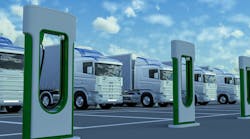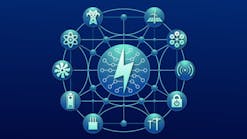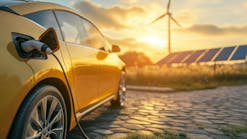Since early in the 20th century, it’s been said that Americans have a “love affair with the automobile.” This love affair has changed little in 100 years, but automobiles sure have, and more drastic change is on the way. The transition from combustion engines to electric batteries has begun and will be enormous for not only vehicle owners and manufacturers, but also electric utilities. Electricity generators, which for many years were the largest greenhouse gas (GHG) emitters in the U.S., relinquished their No. 1 position to the transportation sector in 2016. According to the Environmental Protection Agency, the transportation sector accounted for about 29% of U.S. greenhouse gas emissions in 2019. Although the percentage fell some during 2020 due to lockdowns and restricted travel, it has since climbed and when 2021 data analysis is completed, many experts expect to see emissions levels close to those of 2019.
Passenger cars along with medium and heavy trucks account for about 62% of the transportation sector’s total GHG emissions, globally. Rail, two and three-wheelers, buses and light commercial vehicles along with aviation and shipping make up the remaining 38%, according to Statista. These statistics explain why auto manufacturers are increasing EV offerings for passenger cars, as well as commercial fleet vehicles as residential and commercial & industrial (C&I) customers signal that they no longer want to be part of the climate change problem, but instead part of the solution.
U.S. utilities have reduced carbon dioxide emissions by 40 percent since 2005, according to the Department of Energy, but they still have a long way to go to meet their net zero carbon goals. This is a challenging and expensive task and becomes even more challenging when coupled with the addition of hundreds of thousands of EVs and the infrastructure needed to charge them. I believe if transportation electrification occurs as quickly as many believe, this transition to EVs could become a major grid disruptor likened to the integration of intermittent renewable energy.
So far, electric passenger car charging has been easily absorbed into the grid and hasn’t disrupted utility operations. That could change, however, as C&I customers with fleet vehicles begin to transition those fleets to electricity. Like utilities, they also have sustainability and net zero carbon goals.
I recently spoke to David Schaller, Director of Industry Engagement at North American Council for Fleet Efficiency (NACFE), an organization that works with the North American freight industry to improve efficiency, drive technology advancements, and decrease environmental impact. NACFE is dedicated to doubling freight efficiency, and believes fleet electrification is key to meeting that goal. Schaller said the transportation industry is a long way from electrify large (Class A), long-haul trucks, but the electrification of local and regional transport trucks is already occurring. He pointed out that about half of all Class A trucks sold in the U.S. do not have “sleeper cabs,” which means those trucks leave from and return to the same location daily. These types of fleets will consume a lot of electricity and are ripe for electrification.
The organization’s website is loaded with good information and you might find the Run on Less – Electric demonstration page particularly interesting. It highlights the zero-emission goods movement that is already underway, and contains information and data gathered in 2021 from electric fleet vehicles operated by 13 companies in the U.S. and Canada. These electric fleet vehicles service real routes with real freight. In other words, these are not pilot programs being run by fleet owners, but are in service vehicles. The vehicles in the demonstration together cover market segments that contain about 5.2 million vehicles in North America, Schaller said. He emphasized that these companies, as well as many others, are on their way to converting to full electric fleets.
During T&D World’s Virtual Black Sky Hazards & Grid Resilience event in November, Oncor’s David Treichler, director of strategy and technology, delivered a keynote address in which he talked about potential fleet electrification in Oncor’s service territory. Treichler said Oncor has identified 24,000 existing customers that are also fleet owners, and most have not yet electrified those fleets. Those customers own more than 305,000 commercial fleet vehicles that serve more that 13 percent of the country’s fright movement, Treichler said.
Treichler explained how many customers’ distribution logistic centers are clustered close together near the DFW and Alliance airports, which can be problematic. He talked about how one Oncor customer approached the distribution utility with questions about providing power to a potential new facility that would, among other things, serve as a distribution center for 435 trucks. Those trucks, if all are charged overnight, would require 40 MW of power for just that one building, Treichler said. He explained that because these buildings are so close to one another there is little room for new infrastructure, such as transmission lines and substations needed to bring power into these industrial areas.
I could continue with more statistics and examples about fleet electrification and the challenges electricity providers will likely face, but I think you get the point. I’ll close by letting you know that T&D World plans to publish several stories on fleet electrification in 2022. We also are working on a business intelligence report on the same topic; so, if you receive a survey from us in your inbox soon, please complete or, if you’re not the right person to do so, please send it along to the correct person. In addition, we will cover this topic and reveal some of the findings from our business intelligence report at our upcoming T&D World Conference and Exhibition. Transportation electrification is coming and we at T&D World plan to keep you informed as the pace picks up.


